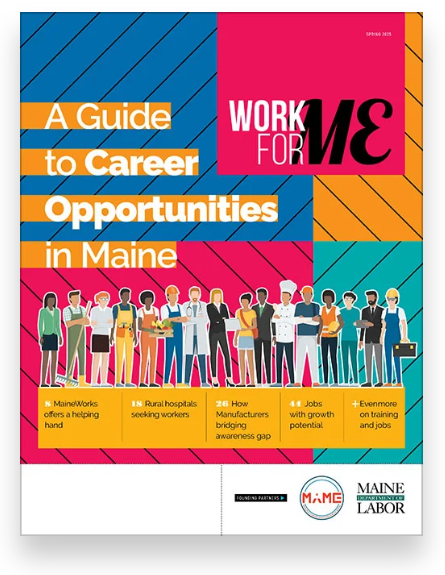End of the exodus? | Maine's manufacturing decline slows, but don't expect a renaissance
But according to a number of recent forecasts, Maine's manufacturing industry may be poised for better days ahead. Last year, for instance, the rate of decline in the state's manufacturing industry slowed, according to an economic forecast recently released by Charles Colgan, an economist at the University of Southern Maine's Muskie School of Public Service.
Michael Miller, an industrial real estate broker at NAI The Dunham Group in Portland, echoed Colgan at last month's Maine Real Estate and
Development Association conference, noting that the mass manufacturing exodus of a couple years ago has slowed. Manufacturers' News Inc., a company in Illinois that tracks manufacturing data, said 287 of the state's nearly 80,000 manufacturing jobs left the state in 2006 ˆ a decline of 0.36%, compared to a loss of about 3.5% in 2004 and 2005.
Miller credits the slowdown partly to more business-friendly local and state legislation. Last year, for example, Gov. Baldacci repealed a 10-year-old business equipment tax that many companies complained was a financial drain. Meanwhile, municipalities from Sanford to Milo, in Piscataquis County, are offering attractive tax increment financing plans to businesses that are expanding.
Maine isn't the only state to see a slower decline in manufacturing. Nationally, manufacturing employment fell 2% from 2005 to 2006, much less than the 7.2% slump from 2001 to 2002, according to the Bureau of Labor Statistics. Colgan reasons that the national economy is just now beginning to recover from the effects of Sept. 11, 2001. "In 2001, 2002, 2003, [Maine] had a big drop in manufacturing because the national economy had slowed," he says. "Now the national economy has picked up," so the decline in manufacturing isn't as dramatic.
Few see the improving numbers as evidence of a manufacturing renaissance, however, and companies continue to eye cheaper locations for their operations. Last month, for example, Attleboro, Mass.-based Sensata Technologies announced plans to relocate its Standish plant to the Dominican Republic by next year, which would put about 200 Mainers out of work.
But such exits could be less frequent in the future. "Three, four, five years ago, everybody you talked to was doom and gloom," Miller says. "Now there's a lot more optimism in the manufacturing sector."
Wanted: skilled workers
Reinvention is one way that Maine's manufacturing industry has stemmed the tide of closures and layoffs. Manufacturers around the state in the last few years have shifted gears, improving efficiency and searching for niche markets in order to stay competitive. "In general, I would say a manufacturer that is embracing change is growing," says Rosemary Presnar, operations director at Maine Manufacturing Extension Partnership, an Augusta-based organization that works to help manufacturers be more efficient. "[Growing] companies are doing niche manufacturing. If you're doing toothpicks or toilet paper, that's obviously not going to do well."
Following a niche has helped Evergreen Manufacturing, a company in Madawaska that packages cosmetics. Since filing for bankruptcy in 1999, Evergreen has rebounded by focusing on small contracts, says owner Jeffrey Albert, who bought the company at auction in 1999. The company had required contracts of 70,000-150,000 bottles of perfume. But now, Albert says, it focuses on packaging orders as small as 2,000-5,000 bottles of up to 200 different perfumes each year. "We're specializing in short runs. That's the niche we've created," he says. "It allows [our customers] to keep their inventory low." The strategy has worked: the company hired 20 people last year to meet rising demand, bringing the total workforce to about 50.
Other companies are starting to make products for growing industries, like energy and technology. Maine Machine Products in South Paris has doubled annual sales to $40 million since 2001 by making components for machines that pump or drill for oil, as well as parts for use in the growing semiconductor industry, says Larry Collins, the company's chief financial officer. The company also has pursued contracts in the defense industry, making parts for armored vehicles for the last couple years.
For many Maine manufacturers, though, rising above the competition also depends on doing quick, custom work. That's helped Sigco Inc., a wholesale glass manufacturer, quadruple sales since 1999. This month, the company is moving from 42,000 sq. ft. in Portland to 72,000 sq. ft. in Westbrook to make room for larger machines. "We make everything custom and we have a fast turnaround," says company owner Dave McIlhinny. "Foreign competition can't do that."
And while orders are piling up for many manufacturers, a constant challenge is hiring enough workers to both fill demand and replace an aging workforce. "When I go out and visit companies, they tell me they're getting more contracts and that they could be doing even more if they had skilled workers to run the equipment," says Carol Fleishman, a consultant for the Maine Metal Products Association in Westbrook.
Faced with vacancies last year, Maine Machine Products hired six people through the Maine MEP's job training program. There are still openings, though. "We are virtually always looking for skilled machinists and programmers," says Collins.
But getting more contracts doesn't necessarily mean more jobs. To be more efficient, some manufacturers are replacing workers with more automated machinery. McIlhinny, for example, doesn't anticipate hiring more people at Sigco's new location, at least not yet. "The equipment we bought should give us a lot more capacity," he says. "[It's] more automated. You've got to become more efficient. That's a basic of manufacturing."
While the state's manufacturing news at the moment may be positive, it's unclear how long the trend will continue. Charles Colgan says it's unlikely the manufacturing sector will remain steady. "In 5-10 years, the more realistic point of view is we'll still see some steady decline," he says. Others, however, like Miller at NAI The Dunham Group, say the worst is over. "The companies that were labor intensive and not highly skilled have left the state ˆ the paper companies, shoe companies," he says. "The remaining ones are here to stay."










Comments